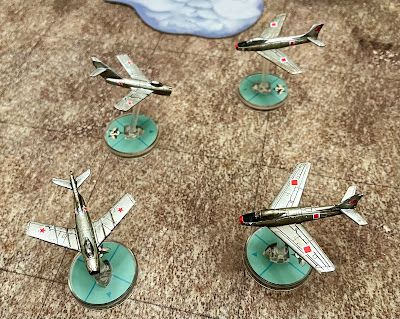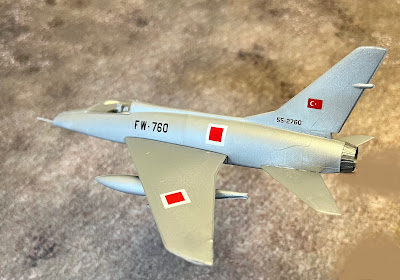A new and an older book has scratched an itch for a side project on a what-if clash between Bulgaria and Turkey during the early Cold War period.
The new book is Hot Skies of the Cold War by Alexander Mladenov and Evgeni Andonov, published by Helion.

The Bulgarian Air Force was Sovietised after WW2 and started to receive the latest Soviet aircraft, including the early jet fighters the Yak-23 and Mig-15. The first 23 Mig-15s arrived in 1951, boxed in crates. More arrived each year after that, totalling more than 100, plus trainers. While there were no open hostilities, the CIA organised incursion flights from Greece. Bulgarian air defences were limited, but Mig-15s made 130 launches in 1954 alone. These incursions had tragic consequences when two Mig-15 pilots shot down an Israeli airliner (Flight LY402) on 27 July 1955, which had strayed into Bulgarian air space. 58 passengers and crew died. This incident takes up most of the book, which, while tragic, is a bit too much. The Mig-17 was a significant improvement because of its all-weather capability. These started arriving in 1955, totalling around 74 by the decade's end. Later versions had radar. The Mig-19 was the first supersonic fighter, ideal for air defence. 84 of these arrived between 1957 and 1959. The book has lots of photos and some excellent colour plates.
The second book, Turkey Between East and West, edited by Vojtech Mastny and Craig Nation, looks at the other side of the hill. It is a series of essays examining different aspects of Turkey's development during this period and later. The book was written in 1996, so the forward-looking chapters are interesting for what they got right and wrong!
Stalin’s attempt to acquire the Straits after WW2 framed Turkey’s relations with the Soviet Union in the 1950s. It brought them firmly into the US sphere of influence through the Truman Doctrine, which brought the US Sixth Fleet to Turkish ports and a steady equipment flow when Turkey joined NATO. This relationship cooled with the Cuban missile crisis and the loss of Jupiter missiles on Turkish soil, followed by the Cyprus crisis of 1963-64.
I also dusted down a few more books on this subject from my shelves for this project. Unlike other Warsaw Pact nations, the Soviets didn't station troops on Bulgarian soil. They relied on advisors, trainers and the KGB, which, coupled with historical links, made Bulgaria a reliable ally. Bulgaria sent advisors and equipment to communist regimes across the world, although they did not participate in combat operations like the Cubans in Angola. There is some evidence that Bulgaria supplied weapons to Kurdish separatists, which is always a sensitive issue in Turkey.
The Bulgarian People’s Army (Bulgarska Narodna Armiya – BNA) consisted of Ground Forces, Air Force, Navy and Border Troops. It is estimated that Bulgaria had 180,000 regular troops in 1951. At its peak in 1955, it had 12 rifle and two tank divisions, falling to six rifle and two tank divisions by the start of the 1960s. The structure was similar to the Soviet organisation, just on a smaller scale. The country was divided into three military districts (Sofia, Plovdiv and Sliven). Conscripts served two years from age 19 (three in the Navy) and then went into the reserve. While part of the Warsaw Pact, the BNA played a limited role, reflecting the lower strategic position and the armed forces' limited combat value. It received older equipment than other Warsaw Pact nations, and most rifle divisions were still foot infantry. The T34 tank was still the primary MBT when other Warsaw Pact armies received or made the T54/55. The 1936 uniform and helmet was still in service until the 1970s. In a conflict between NATO and the Warsaw Pact, the Bulgarians could expect support from Romania and the Soviet Odesa and Kyiv Military Districts.
Turkey had to face the Soviet Union directly on its northern border, a frontier some 620km long. Facing Bulgaria in Thrace was the Turkish 1st Army. A 15-20km deep border zone with Turkey along the 279km long border made intelligence estimates difficult to verify. However, there are obvious invasion routes across the border, and amphibious units were based at Ahtopol, close to the border, which could launch attacks on the Straits. There were extensive fortifications on both sides of the border zone, but once breached, the terrain in Turkish Thrace is primarily open plains. However, access was more manageable from the Greek side over the Evros River, which made it difficult to separate Greece from any conflict. The Turkish Corps based at Corlu would have faced the brunt of any attack from Bulgaria. While there are some defensive positions around Edirne and the wooded Yildiz Daglari, the Turkish strategy would likely follow the historical plan of a fighting withdrawal to the 20km wide Catalea position in front of Istanbul. Additional fortifications were defending the Thracian beaches near the Straits from amphibious assault.
The Turkish armed forces gained some warfighting experience in Korea and joined NATO in 1952. US military equipment arrived in modest numbers, including the M47 MBT. The armed forces implemented some reforms, slimming down the largely infantry army and the number of officers. However, progress was slow, with centralised training only introduced in 1954, and literacy was well below NATO standards. The Navy received US and British WW2-era destroyers and submarines in the 1950s. This was adequate when facing the small Bulgarian Navy, but would be reliant on assistance from the US Sixth Fleet in a conflict with the Soviet Union. Air bases were quickly upgraded after 1952 with modern early warning systems and communications. The Air Force received modern jet fighters, including the F84 Thunderjet in 1953/54, and refurbished Canadair Sabres in 1954/56. The first supersonic F-100 Super Sabres started to arrive in 1958. The first female fighter jet pilot to operate under a NATO flag was Leman Bozkurt Altınçekiç, from the Turkish Air Force, in the early 1950s.
The military had a special position in Turkish society and regularly intervened in politics, including a military coup in 1960. The NATO archives include a period film on Turkey and NATO, which shows Turkish soldiers in their WW2-style British battledress. The helmet was still used as late as the Cyprus intervention in 1974.
Even before the Cyprus conflict, Greece and Turkey were unstable allies, and Bulgarian planning would have taken this into account. Ethnic Turkish groups in Bulgaria (11-15% of the Bulgarian population) were regarded as suspect, although full-scale assimilation campaigns didn't begin until the 1970s and 1980s. In the 1980s, friction between Turkey and Bulgaria over this issue brought both countries close to war, although the US and Soviets would have intervened to stop it.
My first tabletop dabble was a game of Blood Red Skies, with Sabres and Mig-15s dogfighting over Thrace. I haven't found any Bulgarian decals in 1/200th yet, so I had to settle for Soviet ones. Turkish ones are available from Pendraken.
The midweek game this evening will be an armoured clash with a Turkish armoured brigade fighting a rear-guard action on the Thracian plains. This will be in 6mm using Cold War Commander rules.





































